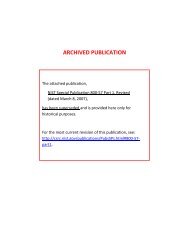NISTIR 7298 Revision 1, Glossary of Key Information Security Terms
NISTIR 7298 Revision 1, Glossary of Key Information Security Terms
NISTIR 7298 Revision 1, Glossary of Key Information Security Terms
You also want an ePaper? Increase the reach of your titles
YUMPU automatically turns print PDFs into web optimized ePapers that Google loves.
NIST IR <strong>7298</strong> <strong>Revision</strong> 1, <strong>Glossary</strong> <strong>of</strong> <strong>Key</strong> <strong>Information</strong> <strong>Security</strong> <strong>Terms</strong><br />
Trusted Channel – A channel where the endpoints are known and data integrity is<br />
protected in transit. Depending on the communications protocol<br />
used, data privacy may be protected in transit. Examples include<br />
SSL, IPSEC, and secure physical connection.<br />
SOURCE: CNSSI-4009<br />
Trusted Computer System – A system that employs sufficient hardware and s<strong>of</strong>tware assurance<br />
measures to allow its use for processing simultaneously a range <strong>of</strong><br />
sensitive or classified information.<br />
SOURCE: CNSSI-4009<br />
Trusted Computing Base (TCB) – Totality <strong>of</strong> protection mechanisms within a computer system,<br />
including hardware, firmware, and s<strong>of</strong>tware, the combination<br />
responsible for enforcing a security policy.<br />
SOURCE: CNSSI-4009<br />
Trusted Distribution – Method for distributing trusted computing base (TCB) hardware,<br />
s<strong>of</strong>tware, and firmware components that protects the TCB from<br />
modification during distribution.<br />
SOURCE: CNSSI-4009<br />
Trusted Foundry – Facility that produces integrated circuits with a higher level <strong>of</strong><br />
integrity assurance.<br />
SOURCE: CNSSI-4009<br />
Trusted Identification Forwarding – Identification method used in information system networks whereby<br />
the sending host can verify an authorized user on its system is<br />
attempting a connection to another host. The sending host transmits<br />
the required user authentication information to the receiving host.<br />
SOURCE: CNSSI-4009<br />
Trusted Path – A mechanism by which a user (through an input device) can<br />
communicate directly with the security functions <strong>of</strong> the information<br />
system with the necessary confidence to support the system security<br />
policy. This mechanism can only be activated by the user or the<br />
security functions <strong>of</strong> the information system and cannot be imitated<br />
by untrusted s<strong>of</strong>tware.<br />
SOURCE: SP 800-53; CNSSI-4009<br />
Trusted Path – A means by which an operator and a target <strong>of</strong> evaluation security<br />
function can communicate with the necessary confidence to support<br />
the target <strong>of</strong> evaluation security policy.<br />
SOURCE: FIPS 140-2<br />
Pg 197

















